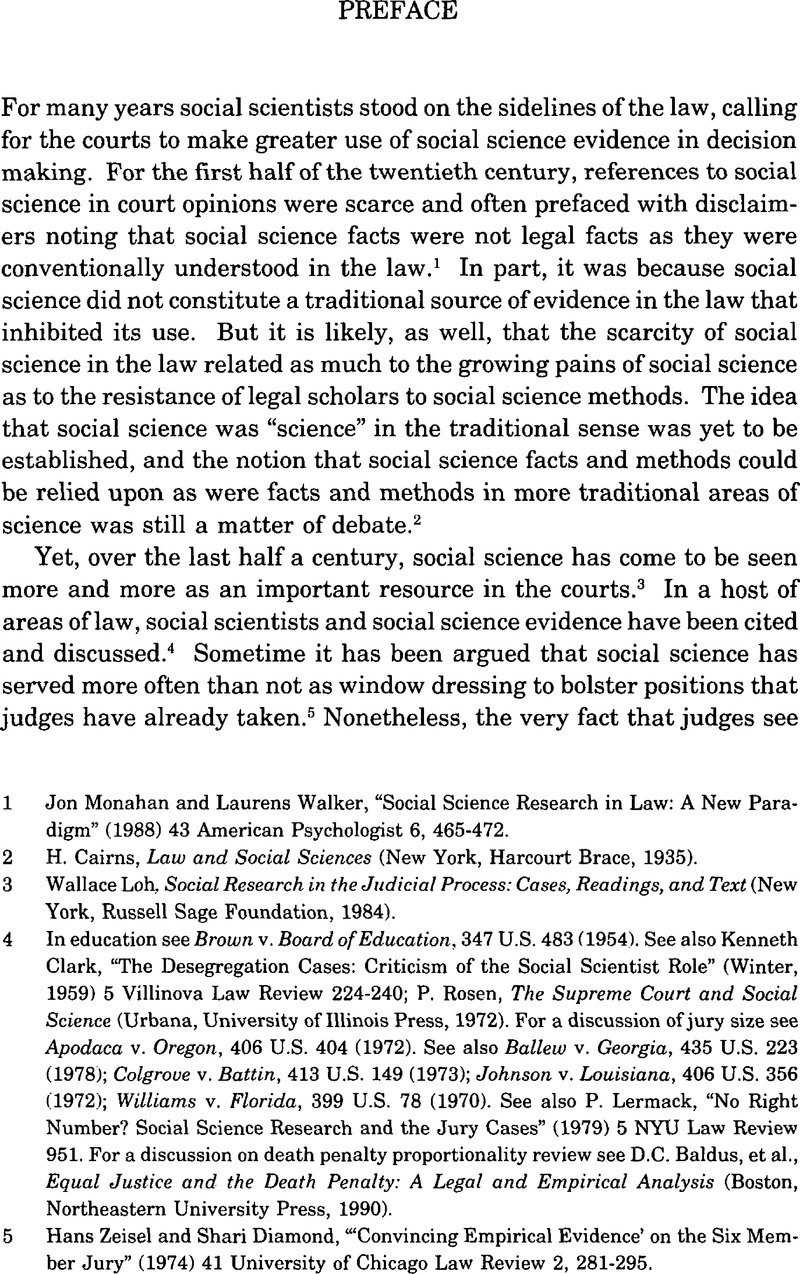No CrossRef data available.
Article contents
Preface
Published online by Cambridge University Press: 04 July 2014
Abstract

- Type
- Other
- Information
- Copyright
- Copyright © Cambridge University Press and The Faculty of Law, The Hebrew University of Jerusalem 2001
References
1 Monahan, Jon and Walker, Laurens, “Social Science Research in Law: A New Paradigm” (1988) 43 American Psychologist 6, 465–472CrossRefGoogle Scholar.
2 Cairns, H., Law and Social Sciences (New York, Harcourt Brace, 1935)Google Scholar.
3 Loh, Wallace, Social Research in the Judicial Process: Cases, Readings, and Text (New York, Russell Sage Foundation, 1984)Google Scholar.
4 In education see Brown v. Board of Education, 347 U.S. 483 (1954). See also Clark, Kenneth, “The Desegregation Cases: Criticism of the Social Scientist Role” (Winter, 1959) 5 Villinova Law Review 224–240Google Scholar; Rosen, P., The Supreme Court and Social Science (Urbana, University of Illinois Press, 1972)Google Scholar. For a discussion of jury size see Apodaca v. Oregon, 406 U.S. 404 (1972). See also Ballew v. Georgia, 435 U.S. 223 (1978); Colgroue v. Battin, 413 U.S. 149 (1973); Johnson v. Louisiana, 406 U.S. 356 (1972); Williams v. Florida, 399 U.S. 78 (1970). See also Lermack, P., “No Right Number? Social Science Research and the Jury Cases” (1979) 5 NYU Law Review 951Google Scholar. For a discussion on death penalty proportionality review see Baldus, D.C., et al. , Equal Justice and the Death Penalty: A Legal and Empirical Analysis (Boston, Northeastern University Press, 1990)Google Scholar.
5 Zeisel, Hans and Diamond, Shari, “‘Convincing Empirical Evidence’ on the Six Member Jury” (1974) 41 University of Chicago Law Review 2, 281–295CrossRefGoogle Scholar.
6 Diamond, Shari Seidman, “Using Psychology to Control Law: From Deceptive Advertising to Criminal Sentencing” (1989) 13 Law and Human Behavior 3, 239–252CrossRefGoogle Scholar.
7 David Weisburd, “Magic and Science in Multivariate Sentencing Models: Reflections on the Limits of Statistical Models” (this issue).
8 See Malcolm Feeley and David Nelkin for discussion of the distinct voices in social science and how their relevance to legal issues may vary (this issue).
9 Horowitz, Donald, The Courts and Social Policy (1977)Google Scholar; see also Lermack, supra n. 4, and see also Sperlich, Peter, “Social Science Evidence and the Courts: Reaching Beyond the Adversary Process” (1980) 63 Judicature-Chicago 6, 280–289Google Scholar.
10 See Lockhart v. McCree, 476 U.S. 162 (1986); McClesky v. Kemp, 481 U.S. 279 (1987).
11 Bagatz 2491/02 Mordechi Ben Ari v. Judge Arbel, Director of the Courts (2002) not yet published. Mordechi Ben Ari, a doctoral student in the Institute of Criminology of the Hebrew University, requested permission of the Court System to interview criminal court judges or to distribute among the judges a written questionnaire for his doctorial dissertation. Following the second refusal by the Director of Courts to allow the interviewing or distribution of questionnaires to sitting judges, Mr. Ben Ari applied to the Israel Supreme Court sitting as the High Court of Justice (Bagatz). In their decision all three Bagatz judges agreed with Judge Arbel's decision to refuse to allow the interviewing or distribution of the questionnaires to the judges. The Bagatz judges stated that the publication and discussion of the judges' personal views and opinions would interfere with the judges' appearance of impartiality and interfere with the public's belief that they could receive a fair and impartial trial and sentencing.




